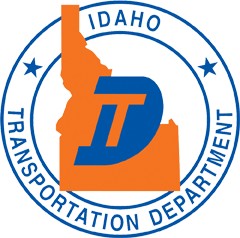After completing a Targhee Pass Environmental Assessment, the Idaho Transportation Department is proposing animal detection systems along the U.S. Highway 20 corridor near the Montana border to reduce the number of vehicle/animal collisions.
ITD has not recommended building wildlife crossings, a proposed solution that failed by a wide margin in a November advisory ballot measure.
ITD will host a public meeting Jan. 17 where Fremont County residents can ask questions and make comments regarding the Targhee Pass Environmental Assessment and the department’s recommendation.
The study evaluates the risks, benefits, opportunities and costs of the reconstruction of Targhee Pass, a stretch of Highway 20 from Ashton to the Montana state line which was targeted for updates in 2016 by the Federal Highway Administration.
The highway reconstruction is meant to “improve roadway structural integrity, traffic flow, and safety of the Targhee Pass segment of U.S. 20 (milepost 402.1 to 406.3),” the study said.
The Targhee Pass Environmental Assessment, released last month, proposes road improvements and five alternative improvements, one of which is a “no-build” alternative. The other four options propose a unique approach to dealing with wildlife crossing the highway.
The road improvements include:
- An additional travel lane in the uphill direction from state Highway 87 to the Montana state line
- Shoulder widening from 5 feet to 8 feet
- Hill cut to improve stopping sight distance
- Left- and right-turn lanes into Big Horn Hills Estates entrances
- Tree clearing to reduce shade
- Road subsurface reconstruction and drainage improvements
The first alternative is a “no-build” option, meaning ITD would make only maintenance improvements to Targhee Pass.
“ITD would replace and repair the existing pavement, but no improvements would be made to the road base, drainage, road geometry, turn lanes, shoulder width, or number of travel lanes,” the study said.
Alternatives 2 through 5 — which would each include the aforementioned road improvements — propose an additional wildlife design element to reduce vehicle/wildlife collisions.
Alternative 2 proposes wildlife crossings and a fence.
Alternative 3 proposes an animal detection system.
Alternative 4 proposes wildlife fencing on both sides of the road, one wildlife crossing structure and “wildlife crosswalks,” a break in the fence where animals will be led, through electrified mats, to cross the highway. Each crosswalk would come with an animal detection system so that drivers could know when an animal is crossing.
Alternative 5 does not include any permanently installed wildlife elements but rather consists of “operational measures such as variable message signs to alert drivers of potential wildlife presence on the highway,” the study says.
ITD is in favor of Alternative 3, to install an animal detection system along the highway, in addition to the road improvements. The animal detection system, about a dozen solar-powered signs, mounted on 14- to 16-foot poles, would alert drivers to the presence of animals on the highway. Alternative 3 does not include crossing structures or wildlife fencing.
“ITD looked at a number of possible alternatives to improve roadway structural integrity, traffic flow and safety of the Targhee Pass segment of U.S. 20, and identified Alternative 3 as the preferred alternative,” said ITD project manager Derek Noyes in an ITD news release.
If Alternative 3 is enacted, it will put to bed an ongoing debate in Fremont County about wildlife crossings. The issue has divided Fremont County residents throughout the last year, culminating in a November advisory ballot vote. Residents voted strongly in opposition to building crossings and a fence, which would allow animals to cross the highway safely but would come at a hefty cost.
Jerald Raymond, District 35A State Representative, who opposed the wildlife crossings, said recommending Alternative 3, the animal detection system, was the right decision for ITD.
“It has the support of the citizens up there and I think it will accomplish what they want it to,” he said.
Raymond opposed wildlife crossings because of the cost.
“The biggest cost I think came from long-term maintenance of the fences,” he said. “I didn’t think it was in the best interest of the state, financially, to support that.”
Jean Bjerke, a volunteer with Island Park Safe Wildlife Passage, a group that supported wildlife crossings, said the animal detection system will be less effective than a wildlife crossing.
“I believe they made the wrong choice,” Bjerke said. “(ITD) did not follow their stated need, which included as key elements, of course, safety for drivers and animal benefit. Research shows that animals detection systems are less effective than animal crossings.”
Bjerke said, despite ITD’s recommendation, she will continue to advocate for animal crossings on Highway 20.
“I hope we can plant some seeds for future people to act on,” she said. “I hope there will be many people who will speak up in (ITD’s) public comment and say ‘We think you made the wrong decision.’”
The ITD urges the public to review the findings in the environmental assessment and it seeks stakeholder feedback on the document at the public hearing or any time between now and Feb. 1.
To read the study online, visit islandparkus20.com or, to read a printed copy, go to Island Park City Offices, Fremont County Planning & Zoning Office, the Fremont District Library (Island Park Branch), or the ITD District 6 office in Rigby.
The hearing will take place from 4 to 7 p.m. at the Island Park EMS Building, 4124 County Circle Road.
For residents who cannot attend the meeting, comments can be submitted via phone at 208-220-5937, via email at targheepass@langdongroupinc.com or via mail at Idaho Transportation Department District 6 (Attn: Public Information Specialist) P.O. Box 97, Rigby, ID, 83442.



